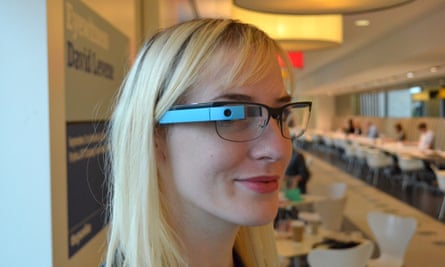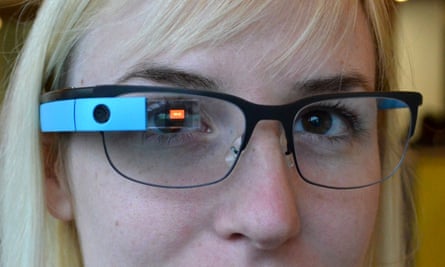A lot of unkind things have been written about Google Glass recently. The internet-connected smartglasses are certainly an early attempt to stake out a piece of the wearable technology market, but unflattering references to their users as “glassholes” can only have contributed to Google’s decision to close its dedicated Glass stores and, it is rumoured, hand some production over to Intel or even shutter Glass completely.
And all this just months after Glass finally made it to the UK. So if you were thinking of laying out £1,000 at Christmas for that special, tech-curio-loving person in your life, here’s what they can expect ...
It’s reasonable to think, having grown up with science-fiction depictions of augmented reality and heads-up displays, that having a screen projected into your vision is the future. It certainly feels like the future when it’s sitting on your face.
A more successful vision for the future of wearable technology, however, has been the rather less ostentatious form of the smartwatch. And while the potential for new ways of working and accessing information via a watch is smaller, so is the social anxiety caused by wearing one.
Wearing them
Glass is about as comfortable to wear as any lopsided pair of glasses. The interchangeable frames are light, the nosepads standard, but one side has the weight of the battery, camera, screen, small speaker and guts of the smartglasses.
For people with short hair, the battery hanging out the back on the right-hand arm won’t be an issue, but it can mess up longer hair and stop you wearing hats or high-necked coats.

During use, Glass gets warm, but not uncomfortably so. The touchpad on the side of the frame works well for scrolling through menus. Tapping on it selects items, while swiping down goes back one step. A camera button on the top of the frame enables quick snapshots or short videos with a little audible chime.
Most actions can be performed either using voice or by tapping and swiping. When awake, saying “OK Glass” triggers the menu system, waiting for another keyword command such as “explore the stars”. Google searches and launching apps works well. Replying to messages is a little trickier via voice; trying to dictate a message of reasonable length with punctuation on any platform is still a little awkward, and no easier on Glass than on a phone or smartwatch.
Head and eye-movement gestures can wake or turn off Glass, make notifications appear in the screen when they come in on a connected smartphone or take photos with a wink. Though only if you can wink with your right eye, which is not a talent I am blessed with.
It is all fairly intuitive, once you’ve watched the startup instructional video.
Reading them

The screen is clearer than you might expect. It floats in the top right hand side of your vision, appearing as a small display projected in front of you. It is semi-transparent and quite crisp, and can be adjusted left and right to fit into the middle of your vision.
People who wear glasses will likely need prescription lenses to make the screen clear enough to read.
White text on a bright background is not easy to read, but looking at something not quite so bright makes it much clearer.
You can watch YouTube videos, browse full websites and view photos on the screen, but most of the time it’s used for displaying small snippets of text.
Some apps, such as Google’s Star Chart, use the full screen to produce a partial augmented reality, mapping constellations over the night’s sky by the angle and direction of your head.
There are quite a few apps available now, so beyond the standard messaging, notifications and calls, you can get recipes sent to the screen, play music, games and videos, control other devices, translate text, buy goods or explore exhibitions.
Battery life
Glass lasted longer than I anticipated, with around eight hours of intermittent use. Shooting video and running apps reduced the battery life, but for general day-to-day notifications, directions and the odd photo it will last as long as a smartphone from 2012.
Glass connects to a smartphone via Bluetooth for data connection while out and about, but has its own Wi-Fi when at home, which is easily configured through a smartphone. It struggles to connect to more complex corporate Wi-Fi, however.
Social pariah
Short of the price, which is no small matter, the biggest problem with Google Glass is the reaction of people around the wearer. It feels socially inappropriate much of the time – if not for the wearer, then for their audience.

Only about 25% of people visibly reacted to me wearing them walking about on the street, about the Guardian, on trains and buses. Of those 25%, quite a few had adverse reactions, with some asking me to take them off and others noticeably wary of me.
I think it’s the presumption that you could be recording video at any time of them without their knowledge. Yes, they can record video, but doing so drains the battery and is impractical. Taking photos and video also emits a small chime, so it isn’t as silent and secretive as you might imagine.
The biggest disadvantage was that my family and friends refused to be seen with me while wearing them. They are not technology-obsessed in the same way I am, but there was nothing I could do to convince them. It was either them or Glass.
Then there’s the price. Google Glass costs £1,000 with a variety of different frames. A smartwatch or similar wearable technology costs under £200.
Verdict
Is Google Glass the future of wearable technology? It was genuinely useful while walking about, quickly glancing at notifications was great, heads-up directions were handy and some of the augmented reality apps were fun.
But most of what Glass does except the head-height photo and video functions can be done either with a smartwatch or a smartphone, if not quite as handily.
Smartglasses have potential without a doubt, particularly for industries where hands-free access to information is crucial, but there is no killer app for consumers yet.
If they were the price of a smartwatch, I would consider buying them, but not at £1,000. Not yet.
Pros: one of the most advanced wearable technology currently available, always-accessible camera, heads-up display, decent selection of apps, interchangeable frames.
Cons: expensive, socially unacceptable, can be uncomfortable with prolonged wearing, little utility that can’t be replicated by something more subtle, no killer app.
Other reviews
Sony Smartwatch 3 review: great design, good screen and decent battery
Smartwatch review: LG’s G Watch R is chunky, masculine, and fast
Motorola Moto 360 review: beautiful smartwatch spoiled by poor battery life
Google smartwatches review: LG G Watch, Samsung Gear Live and Android Wear
Sony Smartwatch 2 review: a second screen for your Android phone

Comments (…)
Sign in or create your Guardian account to join the discussion